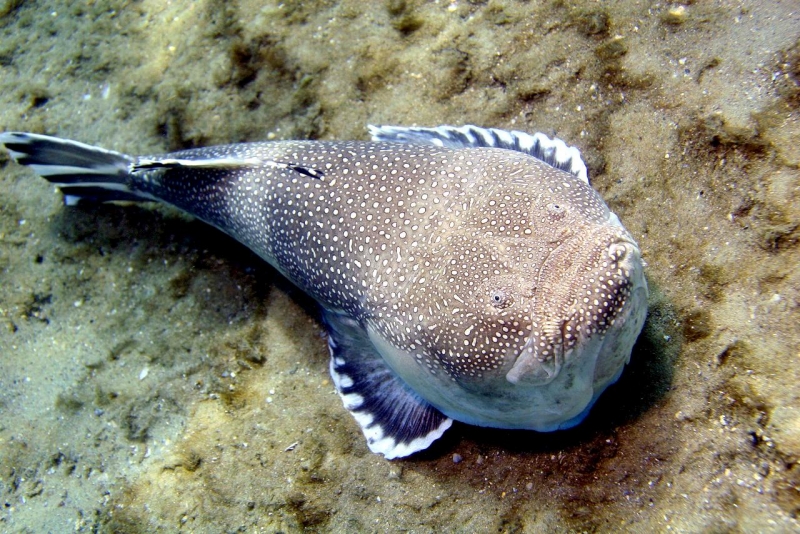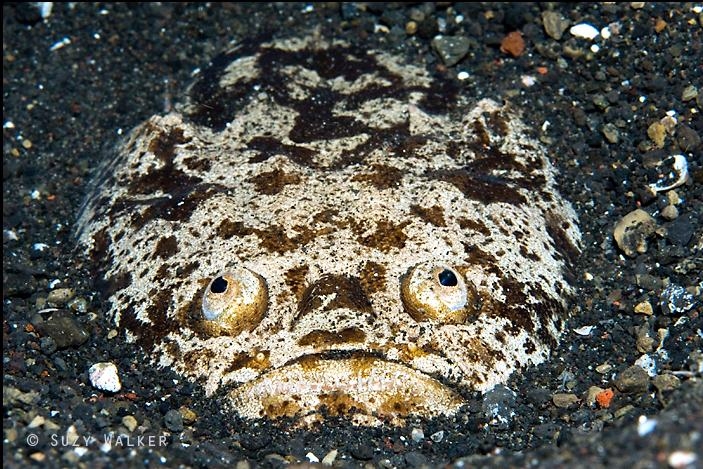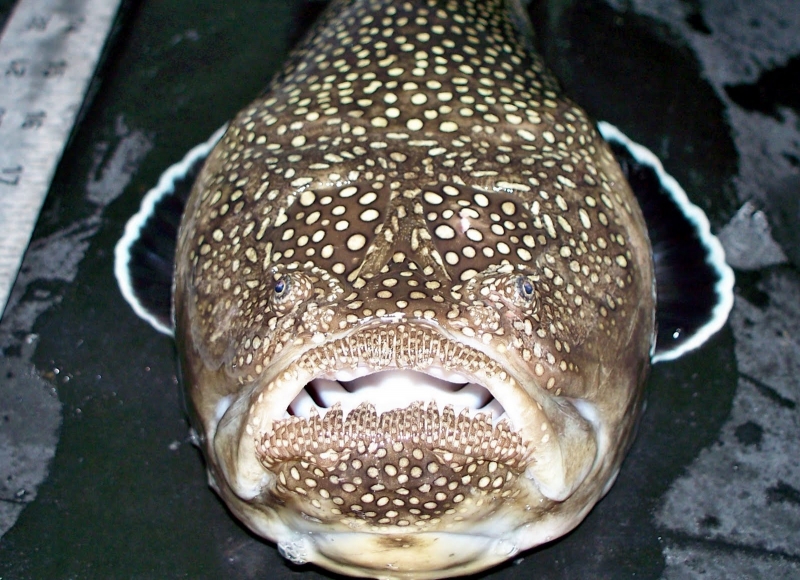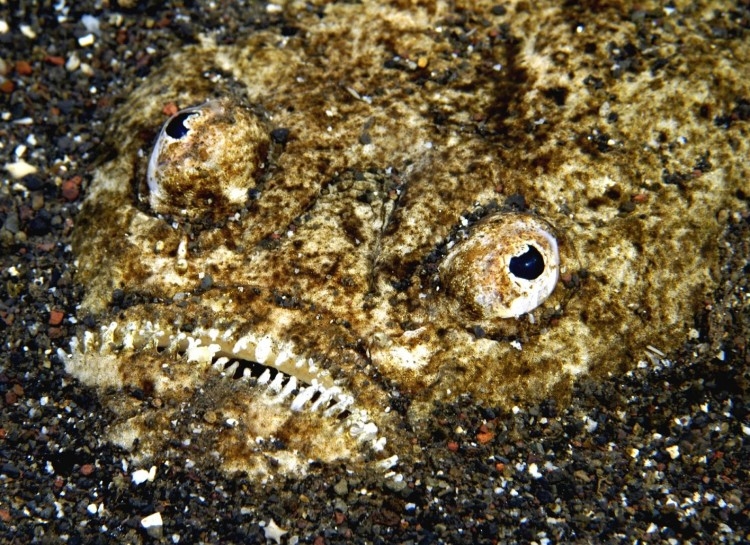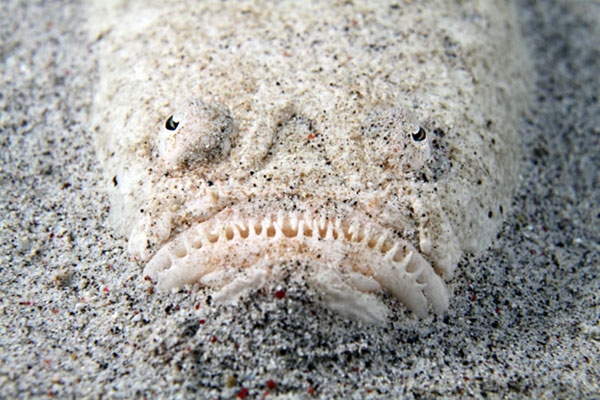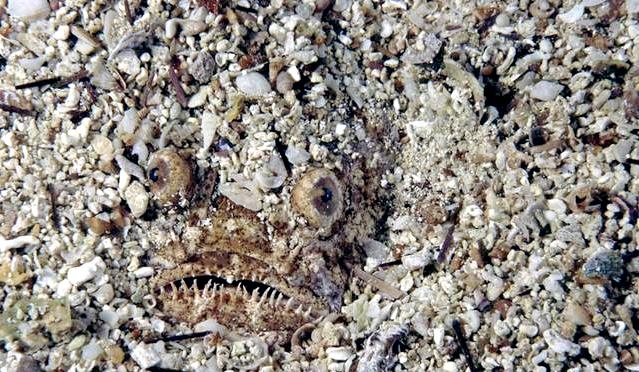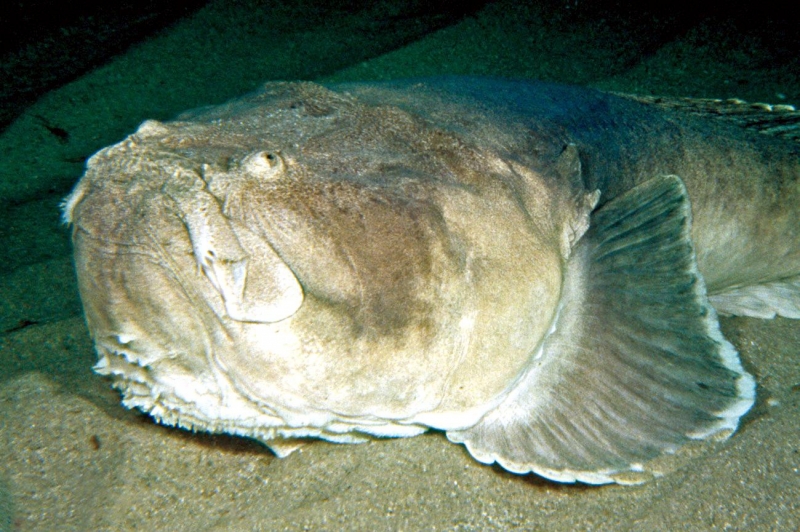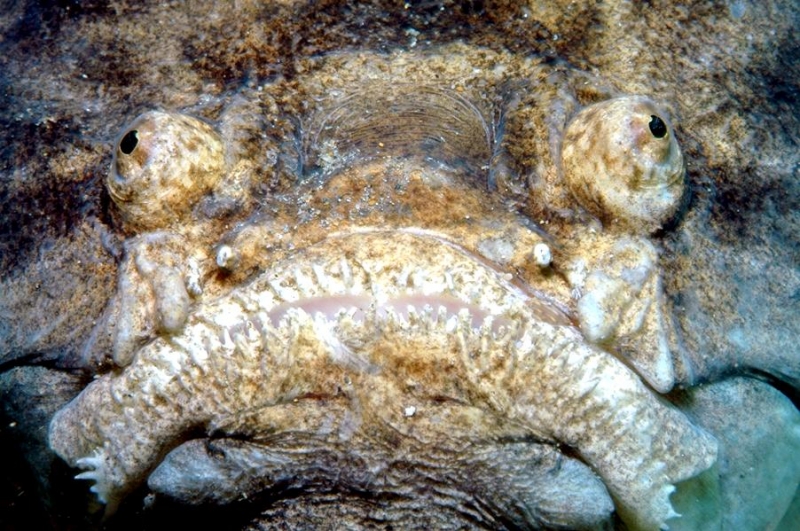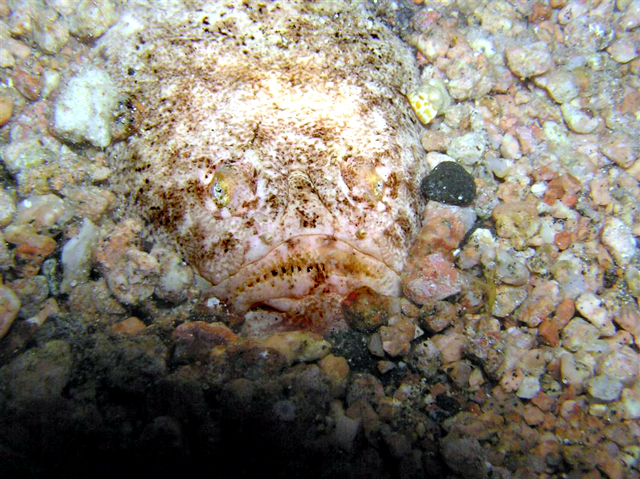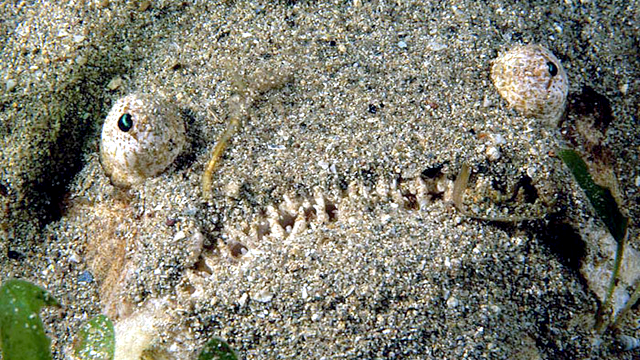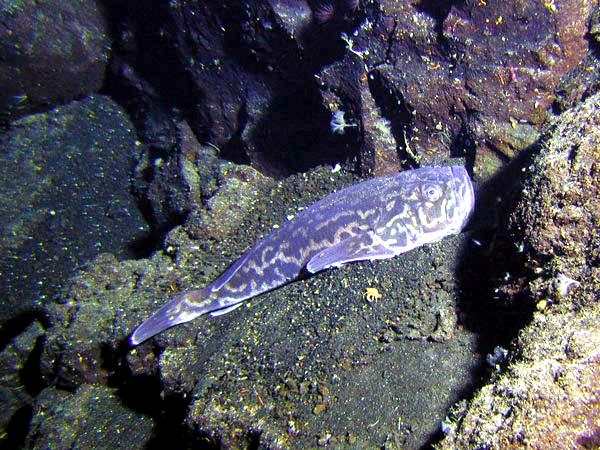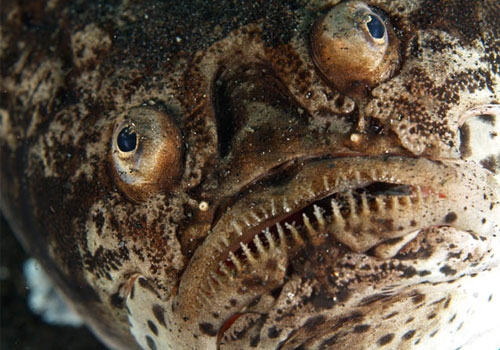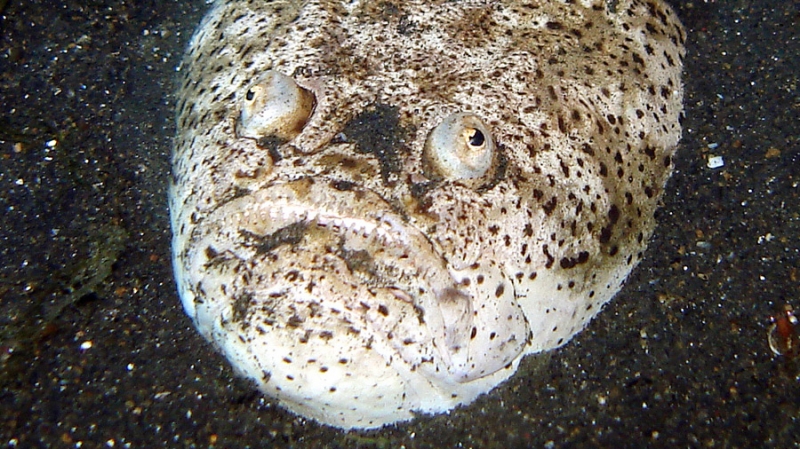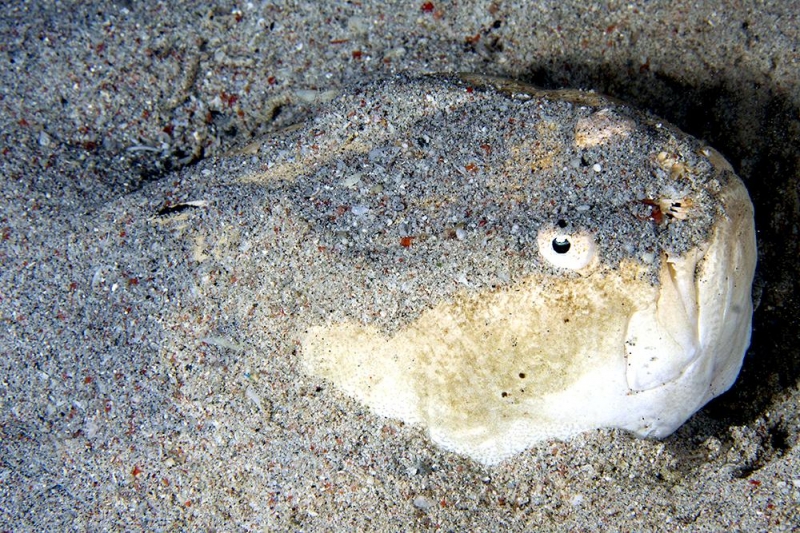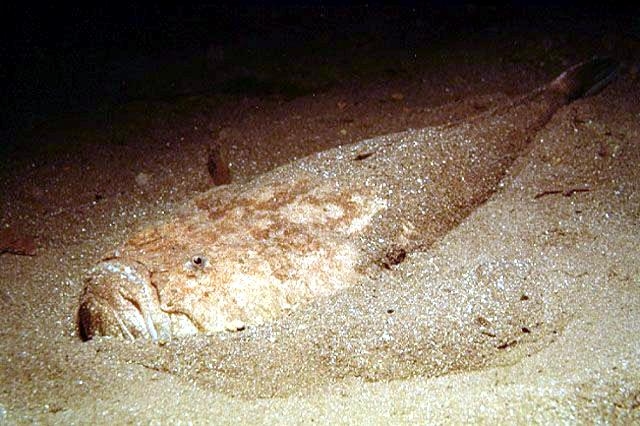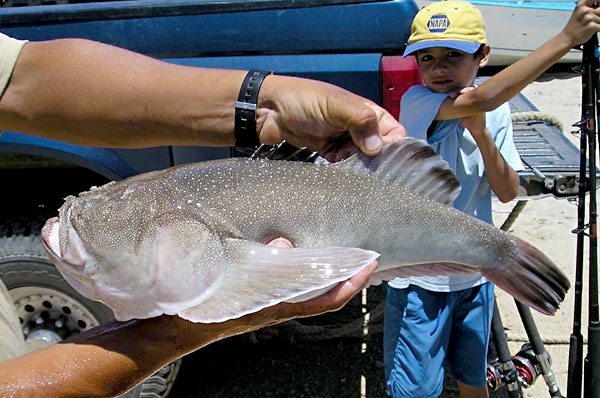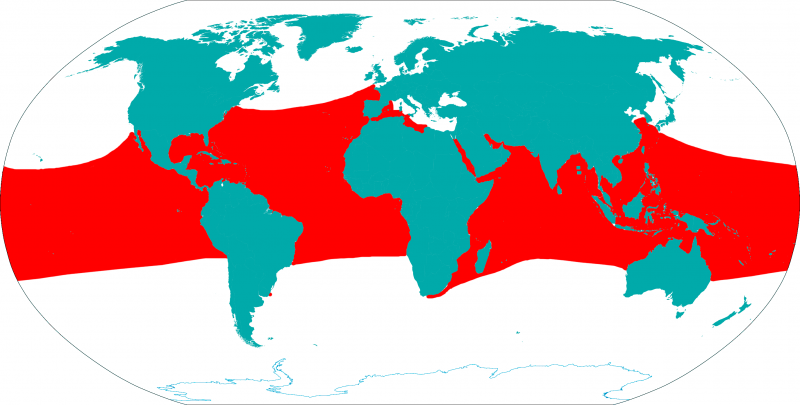“Astroscopus guttatus”
This unfortunate looking fish is called the Stargazer which sounds romantic, but it’s definitely not. Actually, this fish is the antithesis of romance. The Stargazer buries itself in the sand of the ocean floor and lies in wait for its prey. When it senses food is nearby, it can use a jolt of electricity to stun its prey and subsequently devour it. It also has a gigantic mouth which lucky for its camouflage, no prey can identify quickly enough. Once in the vicinity of its gaping mouth, no small fish nor crustacean is safe as it quickly expands and devours it whole. You might think, “But how could any fish not spot something so ugly?” Well, the only thing the Stargazer reveals are its eyes which are situated atop its rugged, spotted, blackish brown body, thus making it nearly invisible to a passerby. Since light is at a premium where the Stargazer hunts, it’s camouflaged quite well making dinner easy to catch. The Stargazer is a bony fish that belongs to the family Uranoscopidae. In all, there are almost 50 species of Stargazers found in 8 different genera. It lives in shallow waters of seas & oceans and is quite commonly found in the Mediterranean Sea and the Atlantic Ocean. It can be described as a benthic species that prefers either to remain buried under the sand or mud or stay on the floor of the sea or ocean bodies. When it buries itself in the sand or mud, its eyes & mouth are the only 2 parts that are visible which is how it gets its name. Researchers have found speckled olive green, brown and white Stargazers. They have an enormous mouth and watchful eyes on their head that are aptly suited for their burying habit. Normally, Stargazers measure up to 8-10 inches (20-25 centimetres), but are capable of catching prey that are 20-22 inches (50-55 centimetres) longer than them. They mostly breed during the spring and summer. The Stargazers belong to the perciform fish from the Uranoscopidae family. They are about 50 species in 8 genera in total, which are found worldwide in shallow waters. For feeding, they usually target other fishes and invertebrates such as crabs. They reside in the depths of an ocean at 25 to 1,200 feet (8-365 meters) deep. Their distribution encompasses almost all seas & oceans on the planet as they thrive in both tropical & temperate water. They have developed delicate strategies to attract a meal compared to other kinds of fish. They bury themselves in sand, flapping their gills causing the sand to stir which puts others under the impression that there is a small creature burrowed. Hiding under the sand keeping only their eyes & mouth observable, Stargazers tend to rotate their eyes freely to further tease their prey into believing that there is a meal secretly veiling itself below the sand. As soon as the prey approaches to investigate, they plunge upwards startlingly fast and grab hold of it with their mouth. This way, Stargazers spend most of their time buried in the substrate. Burying also acts as a defense for them as this process helps them to be camouflaged and perfectly blend to their surrounding environment. They are inoffensive as long as they are not disturbed or provoked. They are believed to deliver electric jolts through an electric organ that is situated behind their eye. The effect of these electric shocks is greater when taken out of the water. This electric charge helps them to wade off predators and confuse their prey. In addition to all this, Stargazers have a venomous spine behind their gills.
They lay tiny translucent eggs at the bottom-most point of the sea. Eventually, the eggs start floating to the surface of the water, where they hatch into larvae of Stargazer. They linger on the top of the water, until they reach the size of 12-15 millimetres (0.5–0.6 inch) in length. Once they grow up to matured adult, they swim back to the depths of the water. Stargazers have an elongated, round-shaped body with a dull-brown color. The upper section of the body has a slightly darker shade of brown as compared to the lower part. It has a large head, which is slightly flattened on the sides and consists of rough, bony plates. On an average, the usual size of the fish varies from 18-25 centimetres. However, there are certain species of the Stargazer that can be as long as 90 centimeters. Its eyes are very small in size and are mounted at the top of the body. It has a large mouth, which is faced in the upward direction. At the tip of its lower jaw, there is a small projection that looks like a worm. Most species of Stargazers have both the dorsal fins & anal fins. However in some of the species, the dorsal fins are missing. This fish is poisonous in nature because of the presence of 2 large poison spines that are located on each of its pectoral fins behind the gill cover. These spines can produce electricity and also deliver electric shocks. It eats a variety of other fish and invertebrates like crabs present in the marine water for its survival. It hides itself under the sand and keeps a watch on its prey. Its body color also helps it camouflage with the surroundings. As soon as it finds a prey nearby, the Stargazer jumps upwards to catch hold of it. Another technique is where it uses the appendage attached to its lower lip. As it appears like a worm, the fish quivers it to attract the prey. Then the prey assuming it as a worm, moves towards it. As it comes near the mouth, the Stargazer creates a vacuum inside the mouth and sucks in the prey fish thus, the prey enters into the open mouth. The breeding season is in spring & summer. The Stargazer lays small transparent eggs at the bottom of the sea. The eggs float to the surface of the water and hatch into larvae. They remain on top of the water until they reach 12-15 millimetres in length. At this stage, they can swim to the bottom of the water, where they grow into mature adult fish. The physical features and adaptability of Stargazers are exceptional indeed. It can cause harm to humans with its venomous spines which can discharge up to 50 volts of electricity. Divers are quite familiar with this species of marine fish particularly night divers. If you are handling live specimens of the Stargazer, you should do so with great care. Usually if humans approach this fish, it will not cause any harm unless it is disturbed.
